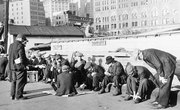The Equal Pay Act of 1963 addressed gender differentials in the workplace and was initiated as a federal anti-discriminatory measure to get rid of wage differences between men and women. The draft bill contained a call for equal pay for comparable work and this had to be amended to "equal work" in order for the bill to make it into the legislature.
20th Century: Women in the Workplace Before 1963
Women composed less than 25 percent of the American workforce prior to World War II, but labor shortages during the war encouraged them to join the civilian workforce and numbers rose to 37 percent. In some ways this move was discouraged as it was felt female workers would downgrade men's jobs, leading to lower rates of pay. Unions began to agitate for equal pay and Congress attempted to pass the Equal Pay Act in 1945. The ensuing heated debate made it clear that pay should be determined by the worth and/or difficulty of work carried out, and this bill was not passed. After the war, because of federal and state practices, men replaced many women in the workplace and where women were retained, pay rates were reclassified and lowered. Of course, as men were primarily in managerial and executive roles at this time, they were in control of the rates of pay, too. Total female workers dropped to 28 percent at this point. As the 1950s progressed, renewed agitation for equal pay led to increasing numbers of female workers, although pay rates stuck at around 59 cents to every dollar earned by men. By 1960, only 15 percent of managers were women and nearly two-thirds of women in the workplace worked in clerical, sales or services jobs. In 1961, President John F. Kennedy established a commission to develop recommendations on achieving female equality at work, leading to the Equal Pay Act of 1963.

Presidential Commission on the Status of Women
President Kennedy's commission was headed by Esther Peterson, a renowned female labor activist who had been legislative representative of the AFL-CIO's industrial union department. She submitted a draft Equal Pay Act to Congress in February 1963. One of the obstacles faced by the original bill was the wording calling for "equal pay for comparable work"; this needed changing to "equal work" in order to pass into statute. The "comparable work" wording had proved difficult to approve in the past and the "equal work" wording was described as work requiring "equal skill, effort and responsibility . . . performed under similar working conditions."
Obstacles to the Equal Pay Act of 1963
President Kennedy's team recognized obstacles facing the Equal Pay Act, including the fact that the workplace was segregated by both gender and race. Furthermore, most women were unlikely to receive equal pay, as their jobs were dissimilar to those of men. But the Equal Pay Act was seen as an important move towards equality in the workplace. Both the U.S. Chamber of Commerce and the National Retail Merchants' Association opposed the Equal Pay Act, arguing that women cost more than men to employ, due to higher absenteeism, staff turnover rates and longer rest break requirements legislated at state levels. The commission issued a report in October 1963 highlighting the discrimination facing women in the workplace, such as lack of promotions or job opportunities, low wages and benefits, sexual harassment and male hostility, alongside employer prejudice regarding time off for pregnancy leave or to deal with domestic problems. The 1960s and 1970s saw the beginning of the women's liberation movement and sexism against women was rife during this period, as highlighted by the commission's report.
Labor Force Participation by Age and Occupation, 1950 to 1960
Statistics for 1950 and 1960 show older women were far more likely to work than younger women, due to home and childcare commitments. Changes in numbers of men in the U.S. labor force showed a decreasing trend across most age groups between 1950 and 1960. The percentage of female employees, on the other hand, increased substantially after they reached the age of 45. In 1960, the most common occupation for working women was in private households, indicative of occupational segregation that negated the effects of the Equal Pay Act. Between the years 1960 and 1970, women aged 16 to 34 showed the largest increase in the workforce, due to higher numbers of working mothers coupled with women's higher educational attainment. Even in 2013, women were still earning only 77 cents to every dollar earned by men. Some of the obstacles to the 1963 Equal Pay Act persist; it was only in 2009 that President Obama signed the Lily Ledbetter Fair Pay Act, in an attempt to raise rates of pay for ethnic minority female workers who were subjects of pay discrimination. The Paycheck Fairness Act, a much needed update to the Equal Pay Act 1963, was still in draft stages as of February 2014.

Related Articles
References
Resources
- National Archives: Teaching, Teaching with Documents, The Civil Rights Act of 1964 and the Equal Employment Opportunity Commission
- National Center for Education Statistics: Bachelor's, Master's, and Doctor's Degrees Conferred by Degree-granting Institutions, by Sex of Student and Discipline Division: 2010-11
- The American Presidency Project: John F. Kennedy, XXXV President of the United States, 1961-1963, Remarks upon Signing the Equal Pay Act
- John F Kennedy, Presidential Library and Museum: Equal Pay Act
Writer Bio
Based in the UK, Dawn Denmar began writing online in 2009. Her writing has been published in her college's student newspaper, "Demon," as well as on various websites. Denmar has a BA (Hons) in history and journalism awarded by De Montfort University, Leicester in September 2013.











